One of the main responsibilities of any project manager is to track project resources so they’re available whenever they’re needed. To do so, they must measure resource utilization. By calculating resource utilization, project managers and employers have a better idea of how to schedule resources such as labor or equipment to minimize costs, increase productivity and meet customer demand.
What Is Resource Utilization?
Resource utilization is a resource planning metric that measures the utilization rate of resources over a period, which allows project managers to identify under or over-allocated project resources.
There are different methods to measure resource utilization, but most project managers use project management software like ProjectManager to facilitate this process. ProjectManager has Gantt charts, timesheets, workload charts, dashboards and other resource management tools. Get started today for free.
ProjectManager’s Gantt chart can create a detailed resource schedule for any project. Map tasks in a visual timeline, allocate resources, estimate costs and track resource utilization with timesheets, workload charts, dashboards and other resource management tools. Get started with ProjectManager today for free.
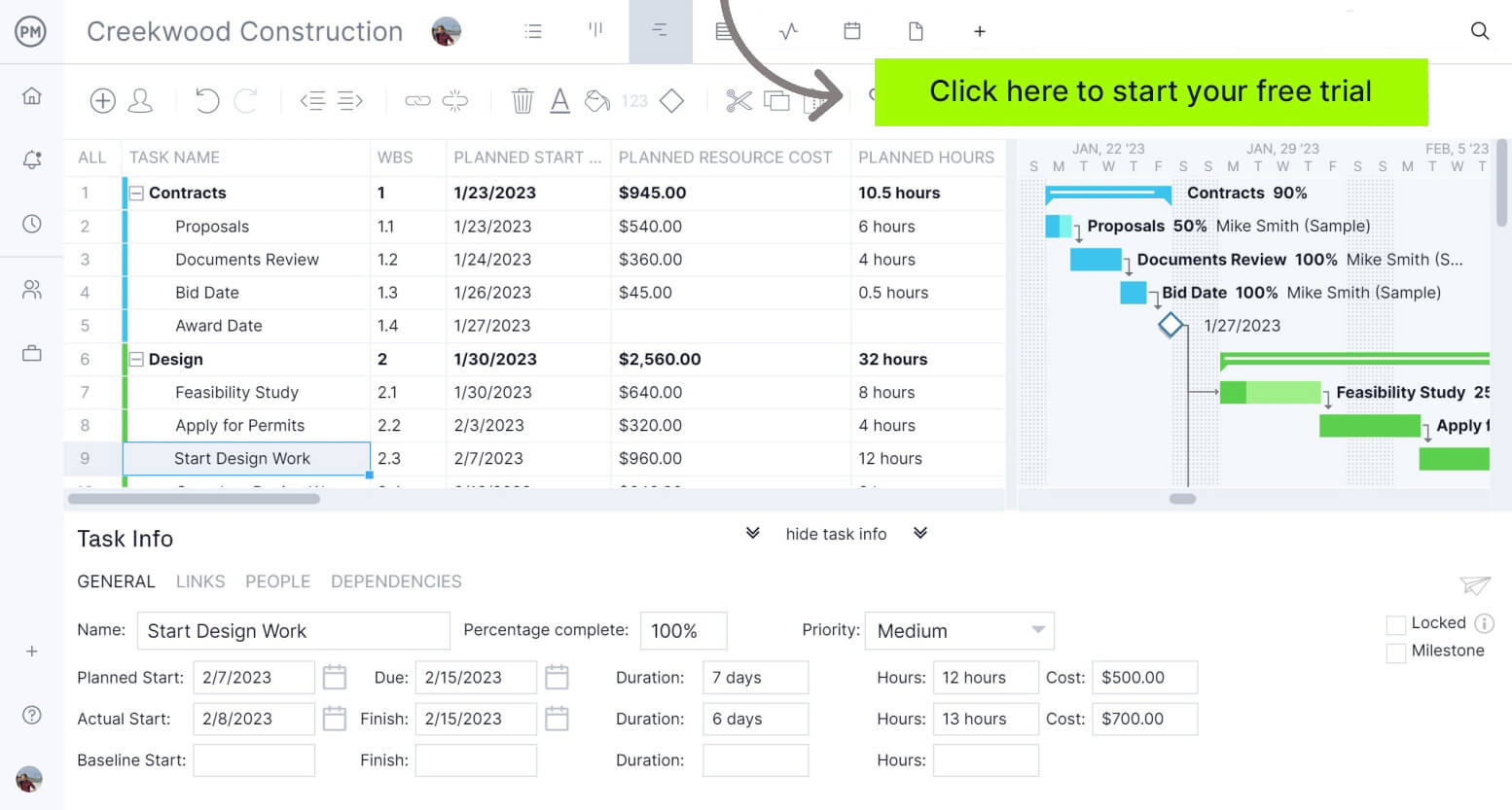
Resource utilization is often confused with resource allocation, but they’re two different resource planning concepts. Here’s how they differ.
Resource Utilization vs. Resource Allocation
While resource utilization measures how resources are being used, resource allocation refers to the process by which a project manager determines the resource requirements for the project, picks his or her team and assigns resources for tasks throughout the project life cycle. This includes reassignments and changes to their team’s workload as needs arise.
Importance of Monitoring Resource Utilization in Project Management
Knowing resource utilization is important for resource scheduling, costs and making decisions such as adjusting the project plan, budget or schedule. Resource utilization also provides visibility into a project. The more transparency and the better to monitor a project, the less likely it is to miss important steps. This helps catch risks before they develop into problems that could sidetrack the project.
This delivers a greater return on investment (ROI). Understanding resource capacity ensures that resources aren’t overtaxed or overused, which leads to greater efficiency and supports the bottom line.
Also, measuring resource utilization is important for the resource management process at large, as it’s needed for resource leveling, resource scheduling, resource planning and resource smoothing. This requires knowledge of the utilization rate of resources.
What Is Utilization Rate?
Utilization rate is a metric that indicates the percentage of the total available resources being utilized by an organization at a given time. This applies to human and non-human organizational resources such as machinery and other capital assets. Their utilization can be measured in work hours, but there are many other variables to be factored in, which are usually included in a resource utilization report.
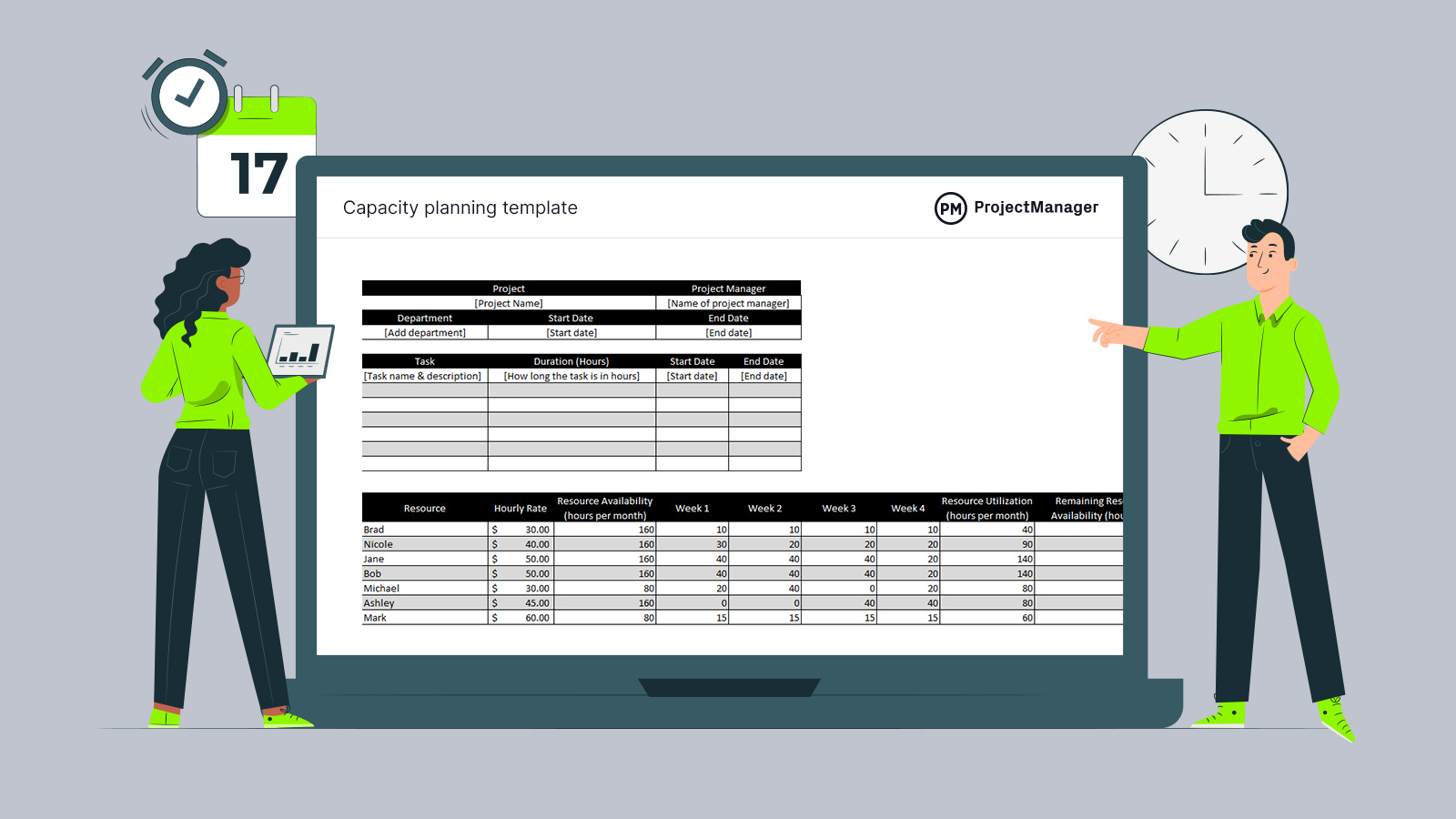
Get your free
Capacity Planning Template
Use this free Capacity Planning Template for Excel to manage your projects better.
What Is a Resource Utilization Report?
A resource utilization report shows the utilization rate of resources to determine what resources are currently available and whether there will be sufficient resources to execute future project tasks.
There is no standard format for making resource utilization reports, but here are a few elements that can be included.
- Labor Costs: One of the key objectives of any resource utilization report is to document the costs associated with the project resources that are allocated for the execution of activities.
- Resource Schedule: Utilization reports should include resource scheduling information to indicate when resources will be utilized and for how long.
- Resource Capacity: Organizations must compare their current resource utilization against their resource forecasts and total resource capacity to determine whether they can take on more projects without affecting their operations.
- Resource Availability: A utilization report should document the current availability of resources of any project or organization, and any resource constraints which constantly fluctuate as tasks are completed.
What Tools Can Be Used to Track the Utilization of Resources?
Here’s a quick overview of some of the most commonly used tools for tracking the utilization of project resources.
Gantt Charts
A Gantt chart is a project scheduling tool that can be used to make a resource schedule. It has two parts, on one side there’s a grid that lists project tasks, resource allocation information, estimated costs, due dates and dependencies. The other half of this chart is a stacked bar chart that helps visualize the tasks in a resource schedule.
Workload Management Charts
Workload management charts show employee utilization rates and indicate which are over or underallocated, so managers can reallocate tasks to balance their team’s workload.
Timesheets
Timesheets record the work hours of employees for payroll processing purposes. They help employers and employees agree on the work that’s been done and its corresponding payment, which is important for tracking project budgets.
Resource Utilization Dashboards
Resource utilization dashboards are ideal for monitoring the everyday utilization of resources of a project or organization. Ideally, organizations should use software with a real-time data dashboard to track the progress of tasks, the utilization of resources, timelines and costs.
Resource Utilization Example
To better understand how resource utilization tracking works, let’s go over a real-life scenario. Imagine that a manufacturer is evaluating purchase orders that have been recently received from potential clients.
Before taking on these projects, the manufacturer must establish its total resource capacity and compare it against its current resource utilization to determine what its current resource availability is. If there are enough available resources, the manufacturer might decide to move forward with these orders.
However, that’s not the only factor to weigh into this decision. Many resource constraints can affect the availability of resources such as supply chain issues, scheduled maintenance activities, machine breakdowns or employee turnover.
Resource Capacity Planning Template
Our free resource capacity planning template helps you monitor your resource utilization. It allows you to list your team members, their hourly rate, weekly availability, and the total number of work hours that are assigned to them.
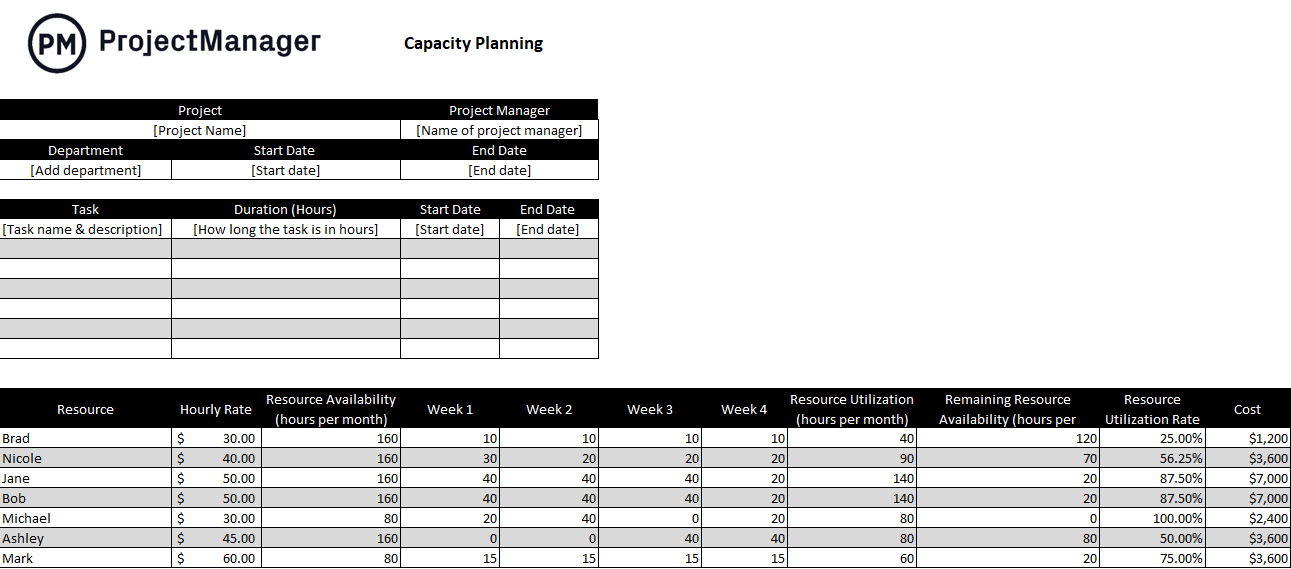
While it’s a useful resource planning tool, this Excel template has limited project resource management features. If you need to manage the resources of your project or organization, you should use resource management software like ProjectManager instead.
How to Calculate Resource Utilization Rate
Even though there’s only one definition of resource utilization, there are different utilization rates to measure which can be used for different resource planning purposes. Here are the main resource utilization formulas.
Utilization Rate Formula
Utilization rate = Total Billable Hours / Total Available Hours
The utilization rate formula is used when project managers need to assess how profitable their resource utilization is which is done by comparing billable hours against the total available hours of a worker.
Billable hours are labor hours that are charged to a client once the work is completed. Usually, project managers should aim for a utilization rate of 0.8 or 80 percent. This is done to guarantee a high billable resource utilization while leaving some room for employees for a healthy life-work balance.
On the other hand, a high non-billable utilization indicates that the team is spending too much time on non-critical tasks.
Capacity Utilization Rate Formula
Capacity Utilization Rate = Total of all employees utilization rates / Total number of employees
Identify the utilization rate for individual team members and then calculate the resource utilization rate for the whole team. To do so, use the capacity utilization rate formula, which averages the team’s current utilization rate.
Optimal Utilization Rate Formula
Optimal Utilization Rate = Resource costs + Overhead costs + Profit margin / Capacity utilization rate
The optimal utilization rate formula balances resource costs, overhead costs and profit margin with the capacity utilization rate.
Ideal Utilization Rate Formula
Ideal Utilization Rate= Resource costs + Overhead costs + Profit margin / Total available hours * Ideal billable rate
The ideal utilization rate formula balances resource costs, overhead cost and profit margin with the total available hours and ideal billable rate, which is the price charged to customers.
How to Streamline Resource Utilization to Be More Productive
Here are some tips to help streamline the resource utilization process so the project team can achieve more while avoiding burnout.
1. Define Billable and Non-Billable Hours
The first step to measuring resource utilization accurately is to define the billable and non-billable activities the project team will execute. Once that’s defined, calculate overall utilization, billable utilization and non-billable utilization.
2. Determine the Available Hours of Each Team Member
Figure out the available hours for each team member based on their contracts, whether full-time, part-time or unit pricing. Now, it’s easier to assign team members work. Use timesheets, resource calendars, resource histograms and other tools to track resource utilization.
3. Use Timesheets to Measure Resource Utilization
Timesheets are an essential tool to measure resource utilization because they document the team’s time, use resource utilization formulas and measure the overall resource utilization.
4. Use the Resource Utilization Formula
Use the resource utilization formulas above and, based on the project’s needs (billable, non-billable or strategic resource utilization), measure the resource utilization.
5. Determine the Employee’s Productivity
Based on the resource utilization analysis, determine which workers are overallocated, under-allocated and which have a low performance based on a peer comparative analysis and the work they’ve done in terms of deliverables.
Resource Management Templates
We have dozens of free project management templates to help manage projects. Here are three templates that are helpful when measuring resource utilization for resource management needs.
Resource Management Plan Template
Our free resource management plan template is a great tool to document the team’s work hours and keep track of them on a timeline. Customize it as needed and then use it as a downloadable Excel file or import it to ProjectManager and the team can access it anywhere, anytime.
RACI Matrix Template
A RACI matrix is an ideal tool to get an overview of a team member’s responsibilities, defining their responsibilities, accountability and roles in the project. Our free RACI matrix template is a great place to start the resource utilization analysis process.
Dashboard Template
Dashboards are a great way of monitoring a project’s health from a high-level perspective. With our project management dashboard template, monitor costs, workload and tasks, making it a great tool to keep track of resource utilization.
Benefits of Managing Resource Utilization
As discussed above, tracking and managing resource utilization is important for both businesses and projects. Here are some main benefits you can get from effective resource utilization control.
- Have a clear picture of your resource availability and resource capacity
- Determine who’s over and under-allocated and distribute tasks more evenly
- Identify bottlenecks and remove them to improve your team’s productivity
- Avoid burnout by properly dividing the work among team members
- Increase profitability by focusing on billable tasks
- Optimize your resource utilization percentage for a better return on investment (ROI)
- Allocate resources strategically so you can complete tasks faster and increase production output
How ProjectManager Calculates Resource Utilization for You
Using different equations to calculate resource utilization takes time. Wouldn’t it be great if there were a tool that automatically made those calculations? ProjectManager is award-winning project management software that does just that.
We have a full suite of project management tools that share data and stay within the same program to manage the project. One essential feature is our resource management software that allocates resources and tracks their costs while giving visibility to the availability of the team, even balancing their workload, all from one tool.
Real-Time Data
Here’s how it works. Because our software is online, project data is always up to date, helping you make decisions with real-time information. See who’s working on what with our team management page. There, get a list of team members with details on their tasks, due dates and progress.
Before assigning tasks, managers need to map team member availability. This can be set up on the team management page, which allows you to determine the team’s working days, holidays and paid time off. This can be done if the team is on-site or distributed anywhere in the world with our global holidays feature.
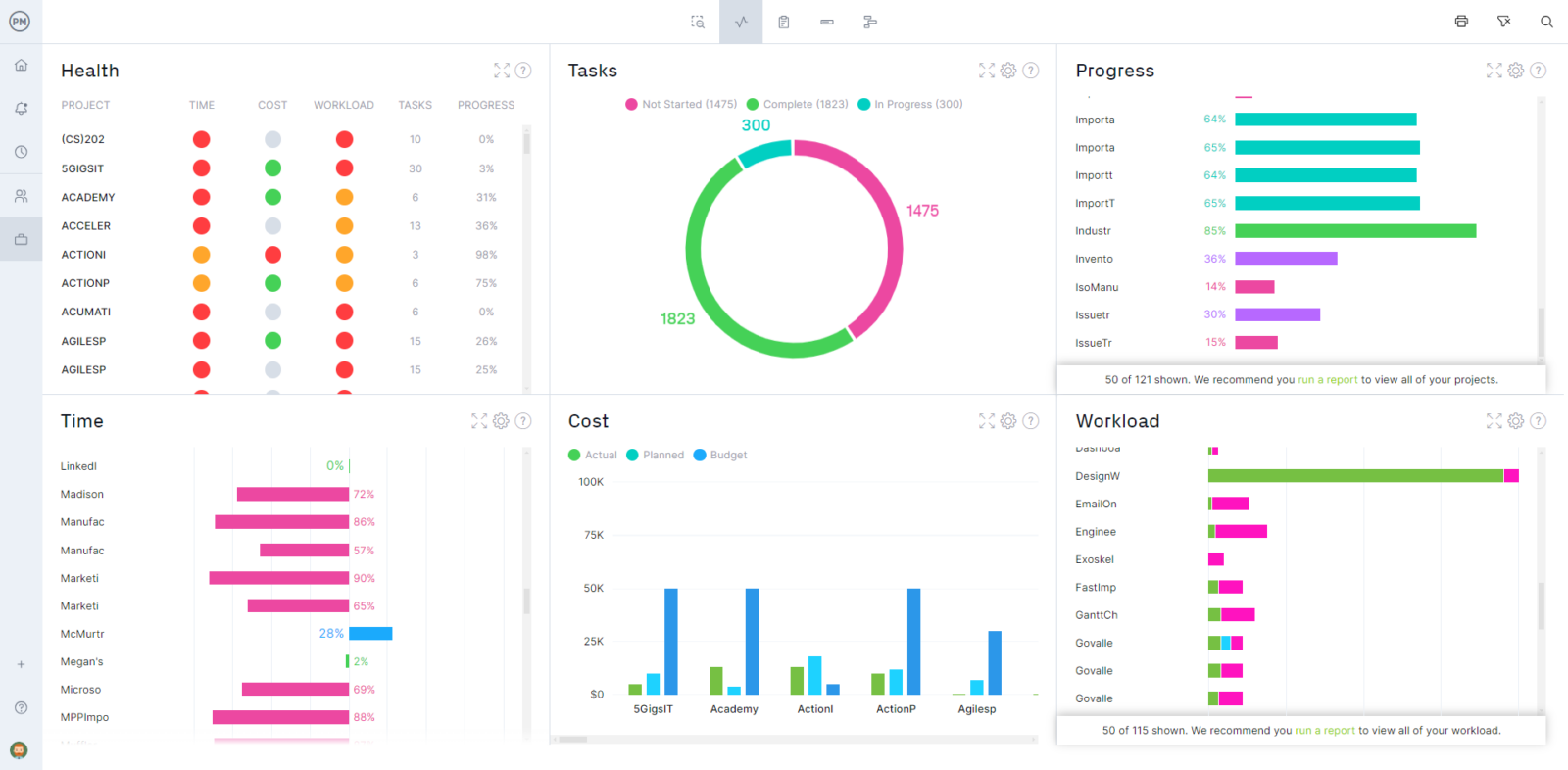
Online Gantt Charts
Once the team’s availability has been blocked, allocate the resources on the online Gantt chart. From this project view, assign team members tasks by seeing how many hours they have to do their job. Note whether they’re over or under-allocated and even get estimates on resource costs.
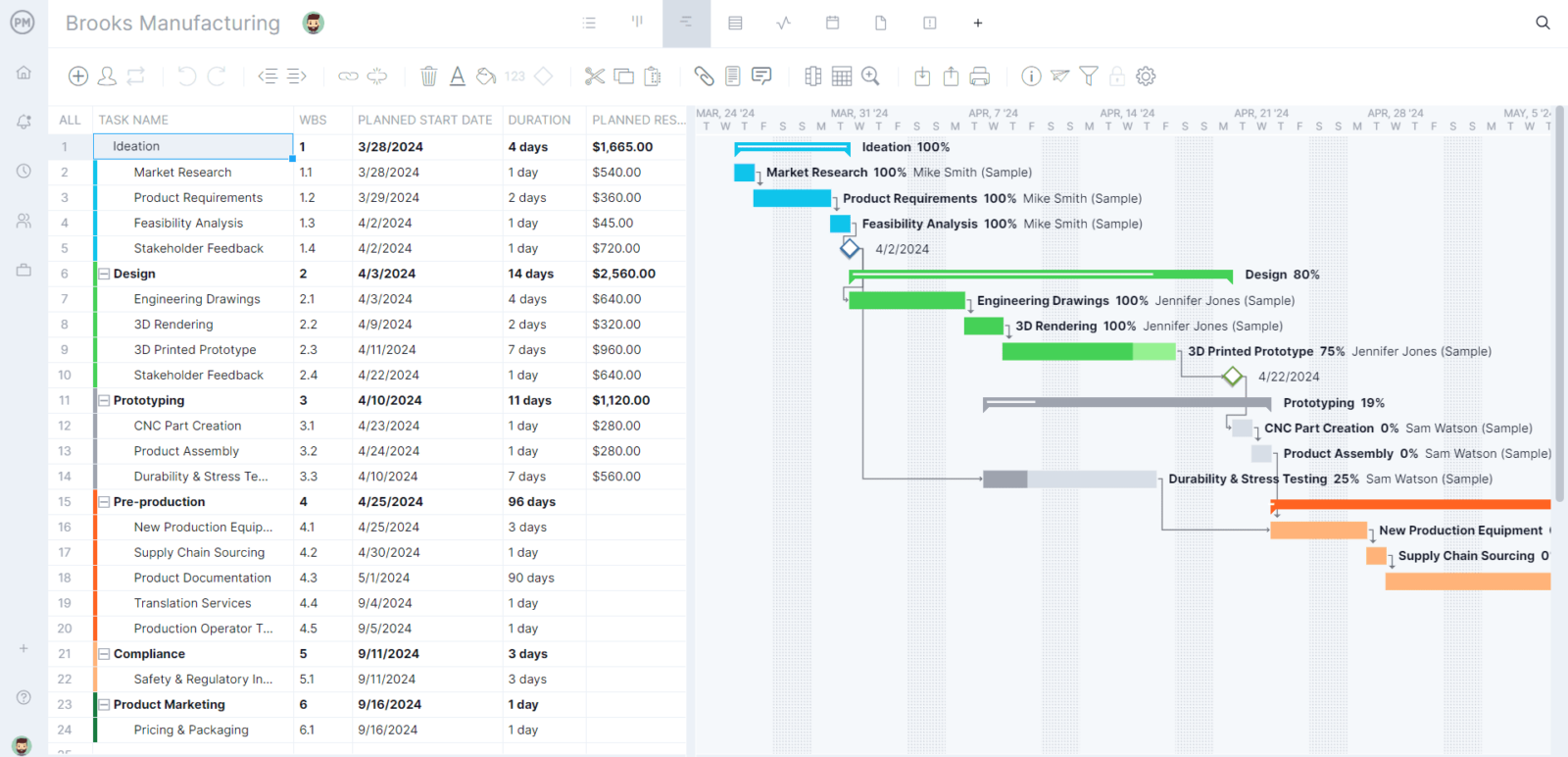
Robust Resource Management Features
The bread and butter of our resource utilization software is the workload page. Use a color-coded workload chart to check if the team members have too many or too few tasks assigned to them. No resource utilization equations are necessary. Best of all, it’s easy to balance their workload to add productivity and avoid burnout, simply reallocate right from the workload page. If you’re managing multiple projects and teams, filter the page by project, team or date.
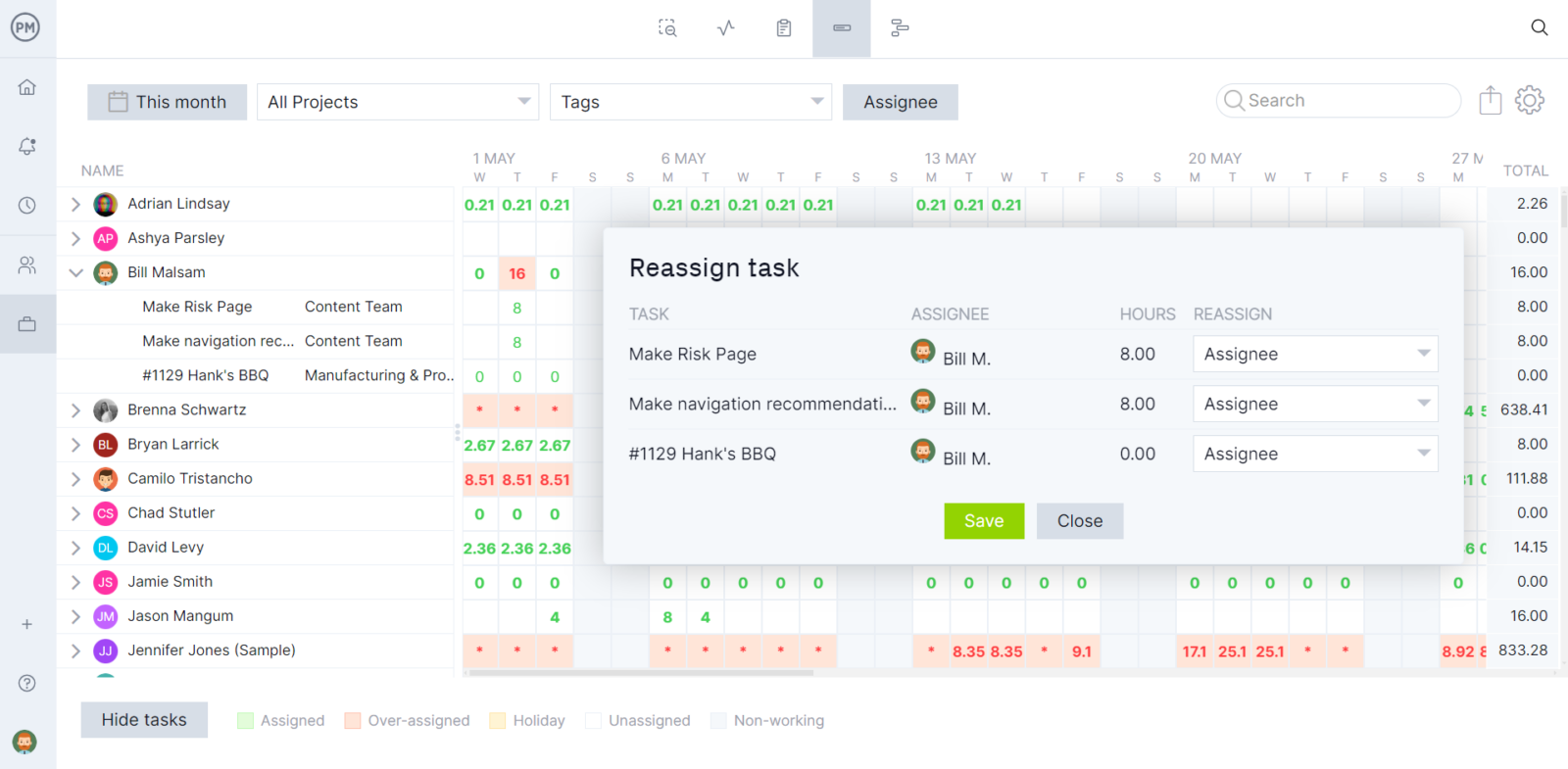
Related Resource Management Content
If you’re still interested in resource management, you’ve come to the right place. ProjectManager isn’t just superior software with robust resource management tools, it’s the online hub for all things project management. You get free templates, blog posts, thorough eBooks, whitepapers and more. Here’s a sample of that content as related to our topic.
- Best Resource Management Software Rankings
- Free Resource Management Templates
- Resource Smoothing Steps, Templates and Tools
- What Is a Resource Histogram in Project Management?
- What Is Resource Loading & Why Does It Matter
- How to Make a Resource Breakdown Structure (RBS)
- Resource Leveling in Project Management: A Quick Guide
- Ressourcenauslastung: Was ist das und wie wird sie gemessen?
There’s so much more that ProjectManager can do to add efficiencies to your project. We have timesheets that automatically update as teams work on tasks so you can track their hours. There’s also a real-time dashboard for high-level views of progress and one-click reporting to get deeper into the data. Plan, monitor and report with one tool. See how it can help you become more productive by taking this free 30-day trial today.

